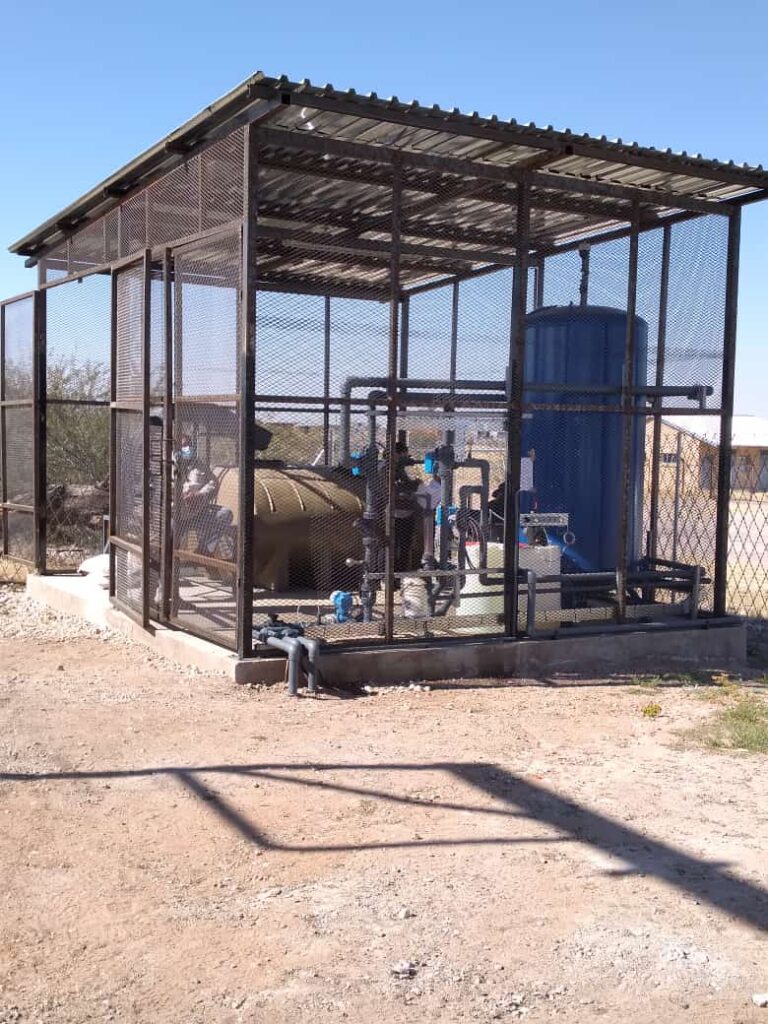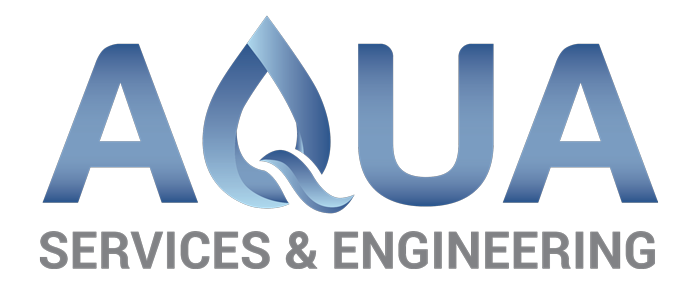Potable Water Treatment
Effective potable water treatment for Lodges & Campsites
Aqua Services & Engineering offers various solutions for all drinking water treatment needs, which include surface water treatment plants, softeners, brackish water desalination plants and various chemical solutions. Our commitment to guarantee safe, dependable and affordable drinking water is backed by decades of hands-on experience at hundreds of water treatment facilities throughout Namibia, applying cutting-edge technologies to ensure customer needs.
Filtration plants for surface water
Many tourism establishments are located along surface waters, especially along the perennial rivers in northern Namibia. While this gives the lodge an almost endless supply of fresh water, this water needs treatment before it can be used at any lodge or campsite.
Aqua Services and Engineering can provide simple, yet effective, small scale direct floc filtration plants. These plants primarily remove any suspended solids and disinfect the water in order to achieve drinking water standards. Typical treatment plant capacities range from 1 to 5 m³/h.
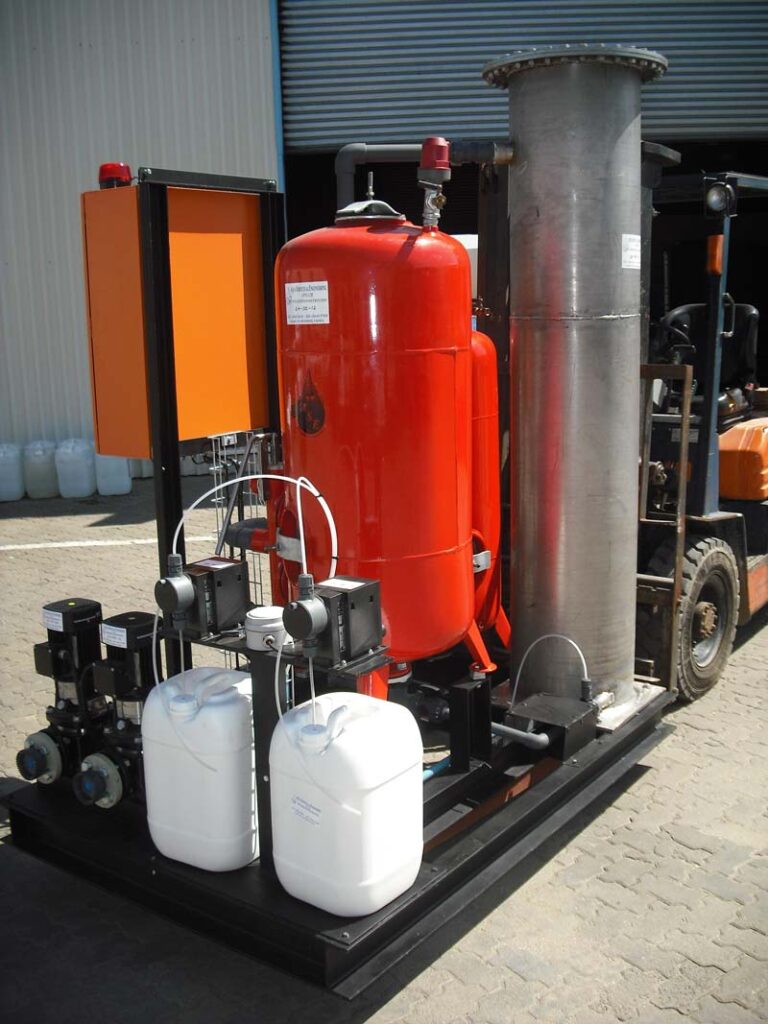
Water softening plants
Many tourism establishments rely solely on boreholes as their primary water source. While many boreholes supply perfectly clean drinking water, elevated hardness levels are a nuisance for water infrastructure such as pipes, geysers, taps etc, due to the associated scaling issues.
Aqua Services and Engineering can provide simple water softening units. These fully automatic units use ion exchange technology to permanently remove the hardness from the water, thereby reducing scaling induced maintenance and repair costs drastically. ASE can offer simplex or duplex units, depending on whether downtime during regeneration is acceptable or not. Our softeners can treat between 1 and 10 m³/h. Larger facilities are purpuse desigend by inhouse process engineers to cutomer requirements
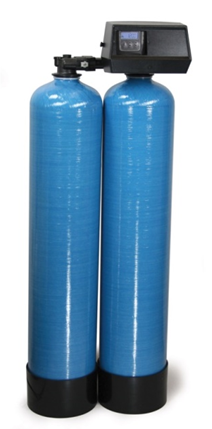
Brackish water desalination plants
Aqua Services and Engineering can offer simple reverse osmosis (RO) membrane plants for the treatment of water that is currently not fit for consumption due to the high salinity of the water. These units are easy to operate and quick to install, with low maintenance costs. The plant capacities range from 250 L/hr to 2000 L/hr for low TDS feed water (Feed TDS < 1500 mg/L). For larger treatment requirements, we also provide customized solutions that are specifically designed to suit the needs of the customer. These plants are adapted to provide the best possible quality at the highest possible efficiency, while taking into account the operational and maintenance needs of the customer.
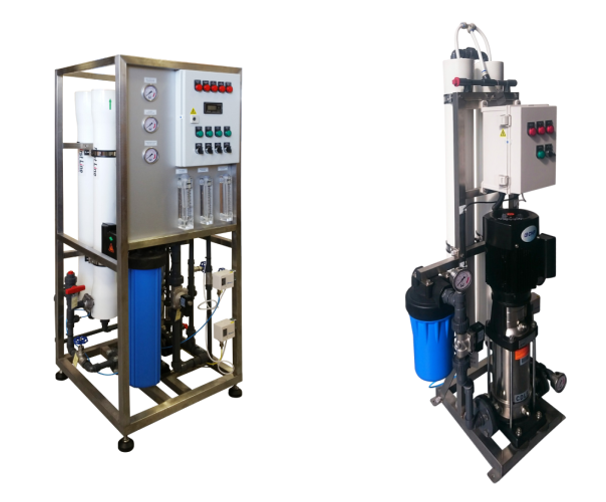
Service and maintenance
We offer the full range of services for water treatment, including analysis and quality monitoring, plant optimisation, planned maintenance, service & repair and emergency assistance.
Potable Water Filtration Systems
New Lamella Clarifier in Outapi
Faced with capacity constraints leading to chronic water supply shortages at Outapi in northern Namibia, NamWater awarded ASE with the supply, delivery, installation and commissioning of a new lamella clarifier to augment the existing treatment system at their plant in Outapi. The enquiry called for a stainless steel high rate clarifier fitted with suitable lamella packs to achieve at least 50 m³/h of additional feed water supply to the existing sand filters at a turbidity of less than 5 NTU, with scope for a suitable solution that could offer even higher production capacity.
ASE supplied and installed a custom-designed clarifier incorporating a flocc column with variable speed mixer to facilitate effective flocculation in order to achieve the highest possible treatment capacity at varying raw water conditions.
Against severe time constraints, the clarifier was installed in November 2022 and is already producing clarified water to augment the strained water supply, thus providing substantial relief of the constrained water supply to the town.
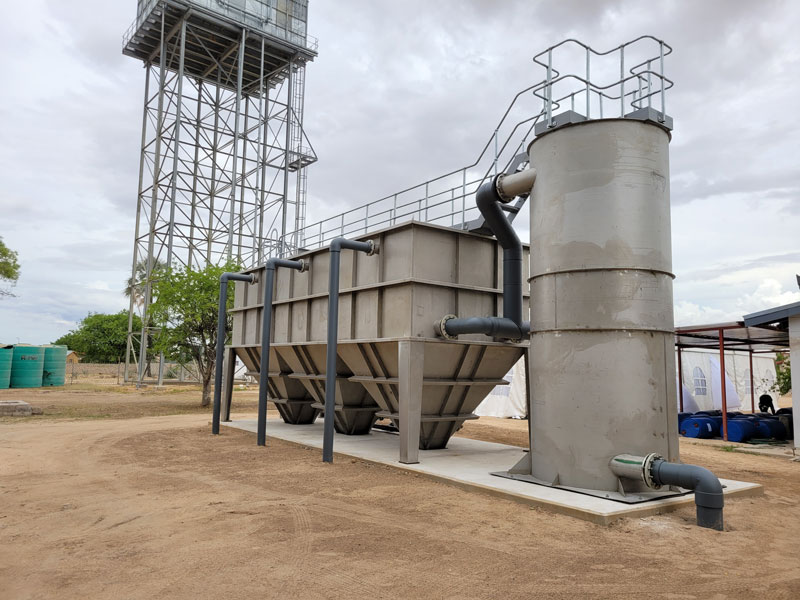
Aussenkehr Water Supply Scheme Treatment Plant
In 2016, the Namibia Water Corporation (NamWater) appointed ASE for the design, supply, installation, and commissioning of a potable water treatment plant to serve the community of Aussenkehr on the banks of the Orange River in the south of Namibia. The treatment plant was designed to treat and deliver 132 m3/h of potable water. However, the process was designed to be scalable to only treat half the capacity (66 m3/h) during off peak seasons, when harvesting is over.
The main treatment deliverable was to achieve a final water turbidity of 0.5 NTU – a final water quality exceeding the current Namibian potable water turbidity standard of 1 NTU. This daunting task was achieved with ASE’s specialized team on board by ensuring the appropriate technologies and chemicals were used, best suited for Namibia’s environment.
The treatment process entailed:
- Abstraction and screening of the Orange River water
- Desilting to accommodate very high river turbidities during rainy seasons
- Coagulation and flocculation
- High rate settling
- Gravity sand filtration
- Disinfection with chlorine gas
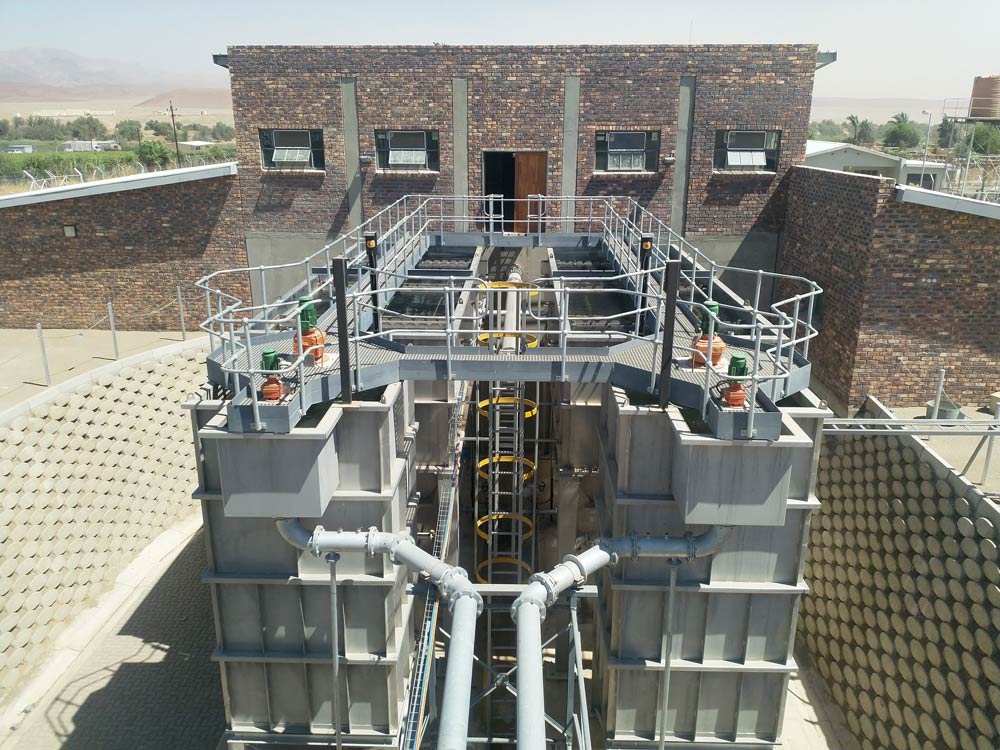
Desalination Systems
Seawater Desalination
ASE was appointed by the Ministry of Safety and Security in 2016 to design and install a solar-powered seawater desalination system for the Police Station at Möwe Bay, situated close to the Skeleton Coast Park on the northern portion of Namibia’s coast. The plant was designed to produce 1 m³/h of potable water with the specific need to operate fully autonomously as there is no power or reliable communications facilities available on site.
The seawater is drawn from a beach well and is pumped through a set of sand and GAC filters prior to a reverse osmosis treatment to produce enough drinking water for the needs of the police station as well as a number of other facilities. The solar power system is designed to provide sufficient continuous power to run the plant during daylight hours.
ASE sucessfully designed and constructed a 400m3 per day desalination plant with high production availability during typical Namibian coastal sulphar outbreaks. The plant uses various process like floculation, dissolved air flotation, sand filtration, chemical conditioning, micro filtration and advance energy recovery stems to reduce energy consumption.
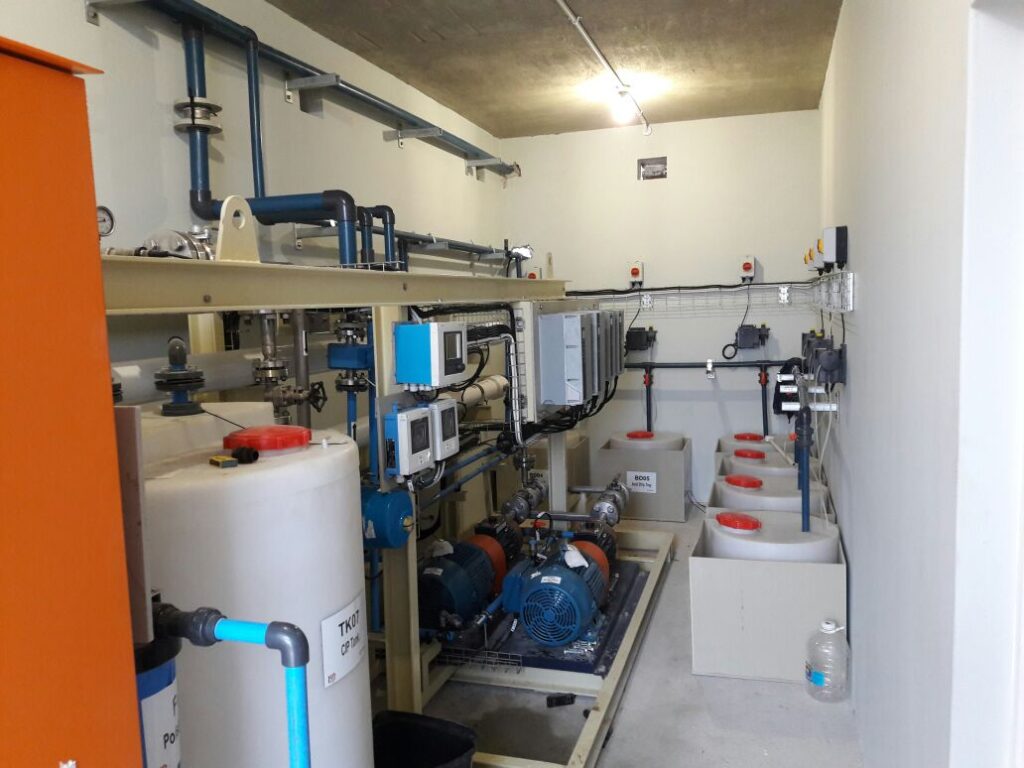
Turn-key Water Treatment Plants
NamWater Eenhana Fluoride Removal plan
The Namibia Water Corporation (NamWater) appointed ASE for the supply and commissioning of a defluoridation package plant with a capacity of 80 m3/h at the Eenhana Water Supply Scheme in Northern Namibia in 2019. The plant was specified to treat the ground water extracted from the Ohangwena Aquifer to Class A requirements, with the main parameter of concern being fluoride at a concentration in excess of 3 mg/L.
While the original enquiry called for a defluoridation plant based on activated alumina adsorption, ASE proposed an alternative approach based on reverse osmosis for the application. This proposal was accepted based on the significantly lower operating costs that were projected for the reverse osmosis plant as opposed to the activated alumina system. ASE provided a containerised reverse osmosis plant with a design capacity of 64 m³/h, with a side-stream blending of the raw water to achieve a stabilised product water with all parameters falling within Class A requirements.
The plant was completed in November 2019, and after a successful trial operation period was taken over and is currently being operated by NamWater, providing consistently excellent drinking water to the town.
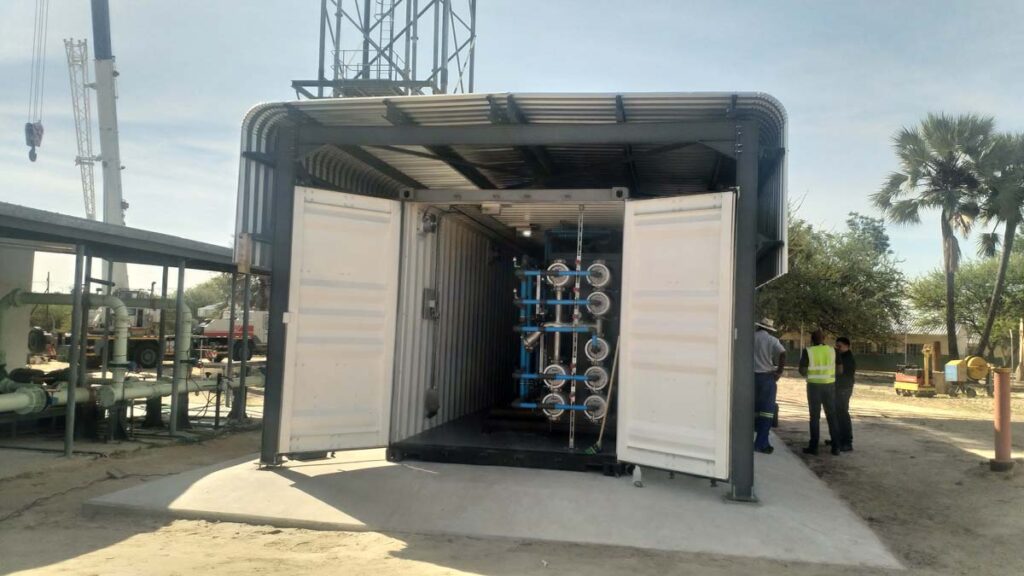
Hoachanas Nitrate Removal Plant
In 2020, Hardap Regional Council appointed ASE for the design, supply, installation and commission a nitrate removal water treatment plant at Hoachanas Settlement, in south central Namibia. While a solution for 20 m³/h was required, ASE offered a simple solution to reduce equipment costs while still ensuring the final nitrate concentration be within the Namibian Group A potable water standard limits.
Ion exchange technology was applied whereby the nitrates of the borehole water are exchanged with chlorides in a resin vessel. This easy to operate system only requires intervention with the make-up of a salt solution to regenerate the resin periodically. Chemically compatible equipment was offered and installed to ensure a robust solution in the remote and harsh environment of Hoachanas.
